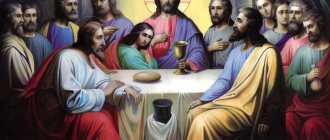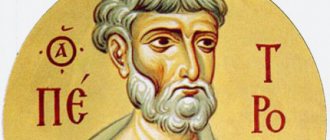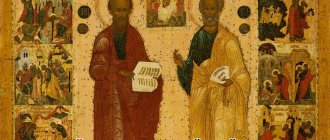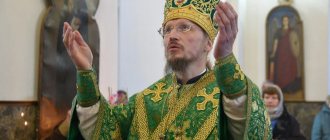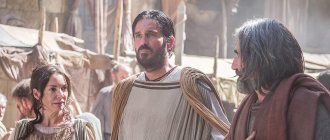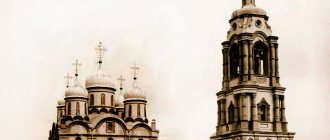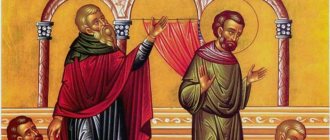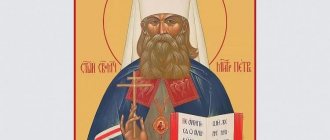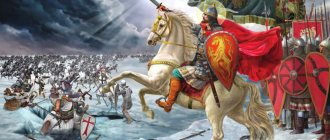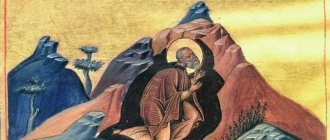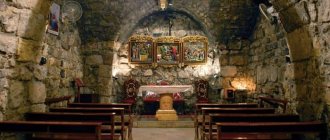“Let us honor Peter, the rock of faith, and Paul, the true teacher...”
The memory of the holy supreme apostles Peter and Paul is a great holiday celebrated on July 12 (June 29, old style). On this day, Peter's fast ends.
History of the holiday in honor of the holy supreme apostles Peter and Paul
The apostles Peter and Paul were very different. The uneducated Peter and the excellently educated Pavel. Peter was the closest disciple of Christ, and Paul was a persecutor of Christians. Peter was married, but Paul was a virgin. But the Church honors them equally: “ Holy and glorious supreme apostles Peter and Paul, pray to God for us!” » The apostles Peter and Paul died as martyrs on the same day - June 29 according to the Julian calendar. This is stated in the Roman (IV century) and Carthaginian (V century) calendars, the martyrology (list of martyrs) of Blessed Jerome (IV century) and the sacramentary (service book) of Pope Gregory the Great (VI century). The Apostle Peter was crucified on the cross with his head down, the Apostle Paul's head was cut off. According to some church historians, the Apostle Paul died exactly one year after the Apostle Peter. The transfer of the relics of the holy apostles took place in 258, also on June 29.
The holiday in honor of the supreme apostles has been known since the first centuries of Christianity. Around 324, during the reign of Constantine the Great, the first churches were built in Rome and Constantinople, the two capitals of the Roman Empire, in honor of the apostles Peter and Paul. From that time on, the holiday began to be celebrated even more solemnly.
How does the icon of Peter and Paul help?
In front of the apostles Peter and Paul on the icon they pray mostly for matters related to faith, because they were active disseminators and preachers of Christianity. Even now they can help ordinary people strengthen their faith and become more righteous. The prayer can be performed to each saint separately or to two at once; if you turn to one person, there is nothing terrible in this; it is even possible to more competently differentiate prayers depending on the goal.
If the emphasis is on the image of Peter in the icon and prayer to this apostle, then he is often approached with requests to be confirmed in the faith, and also fishermen who are assisted by the saint turn to him. In turn, Saint Paul on the icon serves as an image to which people turn in order to receive blessings and help in their studies. After all, Pavel was a deeply educated person and is secretly considered an assistant in various matters related to study and education.
As such, the icon of Peter and Paul is considered miraculous and can grant healing. Sincere faith can do miracles, which is why you should not limit yourself too strictly. It is permissible to ask an icon for almost anything within the framework of the Orthodox faith.
Life of the Apostle Peter
Simple Galilean fishermen Simon and Andrew, having heard the call of Christ: “Follow me!”, leave their nets and become apostles, “fishers of men.” Simon was one of the Lord's closest disciples. A witness to many miracles, long before the Resurrection he speaks about his religion: “You are Christ, the Son of the Living God” and hears in response:
You are Peter, and on this rock I will build My Church, and the gates of hell will not prevail against it (Matthew 16:16-18).
Simon's new names are Peter and Cephas, the Greek and Aramaic words for rock.
The Savior's closest disciples - Peter, John and James - saw His Transfiguration on Mount Tabor, came with him to the Garden of Gethsemane and witnessed His arrest. Peter even cut off the ear of one of the guards. A sincere believer who witnessed the Divine Transfiguration, Peter, on the night of Christ’s passion, denied his Teacher three times, and then “went out, weeping as a mountaineer” (Matthew 26:75). So sincere was his repentance and ardent faith that he heard words of forgiveness from the Lord after the Resurrection:
Do you love me?.. Feed my sheep (John 21:15-17).
It was the Apostle Peter who delivered an inspired sermon after the descent of the Holy Spirit on the day of Pentecost, after which 3,000 people turned to Christ. A few days later, his second sermon, after healing the lame man, converted another 5,000 people to the faith of Christ. Even his shadow healed the sick (Acts 5:15).
The Apostle Peter preached in Judea, the countries of Asia Minor, and Italy. According to church historians, he came to Rome in 67. When Emperor Nero began the persecution of Christians, the disciples persuaded the Apostle Peter to hide. But, leaving Rome, on the Appian Way the apostle saw Christ: “Where are you going, Lord?” Having heard the answer: “To Rome, to be crucified again,” the apostle returned to the city, was arrested and imprisoned in the dungeon of the Mamertine prison. On Vatican Hill, where Nero's circus was located, a cross was prepared for the apostle. Out of humility, he asked to be crucified upside down. Here, on the hill, the holy martyr Clement of Rome and other disciples buried the body of the apostle. Thus the words of the Lord were fulfilled:
Truly, truly, I say to you, when you were young, you girded yourself and went where you wanted; and when you are old, you will stretch out your hands, and another will gird you and lead you where you do not want to go (John 21:18).
Christians erected a small chapel over the tomb of the Apostle Peter in the 2nd century. On the same site, Emperor Constantine the Great built a large temple, consecrated in 329. The relics of the Apostle Peter are located in the dungeon of the basilica. The cathedral is located on the territory of the Vatican State, which is governed by the Pope, the head of the Catholic Church.
Apostle Peter
Before meeting Christ, who named him Cephas ("stone", or in Greek "petra"), Saint Peter's name was Simon. He was born in Bethsaida, in Galilee. His father's name was Jonah. He had a brother, Andreas, his first-born. It was Andrew who introduced Peter to Jesus after first telling him, “We have found the Messiah.” (John 1:42) Simon Peter was married and engaged in fishing, his true passion. This activity helped him withstand the storms of life, taught him to work hard, rejoice in successes and endure failures with fortitude. Simon had a dynamic, spontaneous and easy-going character.
The meeting with Jesus from Nazareth changed his life forever, because from an ordinary fisherman Christ made him a “fisherman of men,” that is, an apostle gathering people around him for the Kingdom of Heaven, which was preached by St. John the Baptist and then Jesus, saying: “Repent, for it has come near.” Kingdom of Heaven" (Matthew 4:7).
Did the Apostle Peter grow up in the Jewish faith? inherited from his family - in the synagogue, in the Jewish and slightly Hellenistic environment of Galilee, where different faiths coexisted. Yet Simon Peter was a simple man, he did not speak Greek, and therefore he had a disciple - John Mark, who, as an assistant, translated for him from Hebrew into Greek.
Life of the Apostle Paul
Before turning to Christ, Paul's name was Saul. He was born in Tarsus, the capital of the province of Cilicia in Asia Minor. He came from the tribe of Benjamin, like King Seoul, in whose honor he received his name. He was a Roman citizen by birth, which gave him enormous privileges in those days, especially in the provinces. He probably also received the Roman name Paul (Latin for “small”) at birth, but began to use it only after turning to Christ.
The future apostle Paul was a zealous Pharisee who studied in Jerusalem with Gamaliel, the most authoritative Jewish teacher of that time. When the first martyr Archdeacon Stephen was stoned, Saul guarded the clothes of the tormentors. He hated Christians so much that he persecuted them anywhere and everywhere. On the way to Damascus, where he was going to persecute Christians, the Lord miraculously called him to apostolic service. Suddenly a very bright light shone and a voice was heard: “Saul, Saul, why are you persecuting Me?” He went blind and fell to the ground. The companions heard only a voice, but saw nothing. They led Saul by the hand to Damascus, where Ananias, one of the seventy apostles, taught him the faith of Christ and baptized him. Vision returned while immersed in water.
Saul became the Apostle Paul. Just as zealously as he had persecuted before, he now preached the faith of Christ in Arabia, Syria, Palestine, Antioch, on the island of Cyprus and in Athens. He founded many local churches, to which he sent his messages, which made up most of the book of the Apostle, read during the morning service in Orthodox churches.
The Apostle Paul, unlike Peter, received an excellent education. He knew well not only the Old Testament scriptures, but was also familiar with the Greco-Roman culture of that time: philosophy, literature, religion, and mastered the techniques of rhetoric. All this allowed him to freely polemicize with Greek philosophers in Athens. The preaching of the Apostle Paul was addressed primarily to the pagans.
When the Apostle Paul once again visited Jerusalem, the Jews accused him of leading the pagans to Solomon's Temple. The Sanhedrin court could not sentence a Roman citizen to death, so he was sent to Caesarea, where the Roman procurator was located in charge of the province. Taking advantage of the right of a Roman citizen to demand the trial of the emperor himself, the arrested Paul, in prison and under escort, travels to Rome. The trial lasted about two more years. Even while in prison, he had the opportunity to see the Apostle Peter and Roman Christians.
Extraction of the water source in the Mamertine dungeon. Fresco in the catacombs of St. Thecla. Second half of the 4th - first half of the 5th century. Rome
According to legend, the apostles spent the last days before their execution together in the dungeon of the Mamertine prison. There they baptized the prison guards Prokes and Martinian and 47 other prisoners. There was no water for baptism, but a miracle happened: the spring began to flow.
The apostles were led together to execution; they said goodbye on the Ostian road. Peter was crucified on Vatican Hill, Paul was taken outside the city to the Salvian waters. A Roman citizen was not supposed to be crucified on a cross, so his head was cut off with a sword. At the place where the head of the apostle fell, three springs gurgled, which have survived to this day.
The body of the Apostle Paul was buried in the same place. Emperor Constantine the Great built a church over the tomb. Subsequently, the basilica was expanded and decorated. The temple was destroyed in a fire in 1823. In 1854, a huge cathedral 120 meters long was built again.
Brief Lives of the Apostles
Both great martyrs had completely different life histories, and therefore it is difficult to imagine that their destinies could be so closely intertwined with each other.
Life of the Apostle Peter
Before meeting Jesus, the man led the life of an ordinary fisherman. The Savior called him while he was fishing on Lake Gennesaret. Peter was the first among the disciples to call the Teacher the Messiah. In gratitude for the recognition, the Lord promised to build a church on the great faith of Petrova.
After the arrest of Christ, the saint was taken into custody, where he denied the Messiah three times. However, then he sincerely repented, atoning for his sin - he completely devoted himself to the teachings of Christ and began to bring it to the people. This is how the Christian faith began to emerge.
The great martyr predicted his death in advance. Returning to Rome, he was arrested and then executed as a martyr. At the request of Peter himself, he was crucified upside down. This event dates back to the 67th year after the birth of Christ.
Life of the Apostle Paul
Unlike Peter, Saul (that was the name of the saint before accepting the Christian faith) was not a disciple of the Savior. He was originally from Jerusalem, having received an education, he was going to become a rabbi. Then, by decree of the local ruler, he was instructed to persecute Christians.
Coming out of Palestine, Jesus appeared to Saul and ordered him to go to Damascus, where the persecutor was brought to faith, and three days later he was baptized. Since then, the former Jew began to zealously preach the holy doctrine, abandoning his previous faith. Later he met other disciples of the Messiah. His first missionary journey lasted 6 years. During this journey the apostle was given the name Paul.
For his ardent faith, the great martyr found himself in custody more than once, until he was executed by decree of Emperor Nero. This happened in the 67th year after the birth of Christ.
Since Peter was a free citizen, he was not crucified, but his head was cut off with a sword.
Service to the Supreme Apostles Peter and Paul
Currently, in Orthodoxy, the feast of Peter and Paul is one of the great ones, equated to the Twelve. On this day, Peter's fast ends, which began a week after the Trinity Day. But if the holiday falls on Wednesday or Friday, then only fish is allowed.
Stichera for the service of Peter and Paul were written in the 7th–8th centuries by Patriarch Germanus , St. Andrew of Crete , St. John of Damascus , Cosmas of Mayum and other Orthodox hymnographers.
Part of the stichera is addressed simultaneously to Peter and Paul:
Thou hast given the establishment of Thy Church, O Lord, to Peter's firmness, and Paul's mind, and bright wisdom, and to both the true voice of God, driving away Hellenic charm. Moreover, we secretly teach from both, we sing to You, Jesus Almighty, Savior of our souls.
Translation: “The establishment of Your Church, O Lord, You gave strength to Peter and Paul, reason and bright wisdom, and to both the true divine preaching, driving away the deception of godlessness. Therefore, we, taught by both of them the mysteries of the Divine, sing to Thee, Omnipotent Jesus, Savior of our souls.”
Other stichera are addressed only to Peter:
The third question is: Peter, do you love Me? Christ corrected the third rejection. Likewise, to the Mystic Simon: Lord, you know everything, you know everything, you know how much I love you. Also to him the Savior: feed my sheep, feed my chosen ones, feed my lambs, who have provided my blood for salvation. Pray to him, God-blessed apostle, to grant us great mercy.
Translation: “Three times: “Peter, do you love Me?” Christ corrected the threefold renunciation. That’s why Simon answered the One Who Knows Secrets: “Lord, You know everything, You know everything, You know that I love You!” Then the Savior turned to him: “Feed My sheep, feed My chosen ones, feed My lambs, whom I purchased with My own blood for salvation!” Pray to Him, God-blessed Apostle, to grant us great mercy.”
There are also such stichera in the service that are addressed to Paul alone:
Even though your bonds and sorrows are all over the city, who can say, the glorious Apostle Paul? Works, illnesses and vigils, even in greed and thirst for malice. Even in winter and nakedness, a knives and beating rods. Throwing stones and contempt. Depths of incineration. It's a shame to be an Angel and a man. You have endured all slaughter in Christ who strengthens you, so that you may gain peace in Christ Jesus your Lord. Moreover, we pray to you, who faithfully create your memory, pray unceasingly for our souls to be saved.
Translation: “Who can list your bonds and sorrows in all your cities, O glorious Apostle Paul? Works, struggles, vigils, sufferings of hunger and thirst, cold and nakedness, baskets and blows with sticks, stoning and contempt of people, the depths in which one drowned in a shipwreck. You have become a spectacle for Angels and people. You have endured everything for Christ who strengthens you, so that you may win the whole world in Christ Jesus your Lord. Therefore, we ask you, commemorating your memory with faith: Pray unceasingly for the salvation of our souls.”
Greatness to the holy apostles:
We magnify you, Apostles of Christ Peter and Paul. Who enlightened the whole world with their teachings and brought everyone to Christ.
During the evening service on the eve of the holiday, paremias are read - excerpts from the conciliar letter of the Apostle Peter. Since the texts of the New Testament book are being read, those praying listen to them standing (usually you can sit during the proverbs). At Matins, two canons written by St. John of Damascus (8th century) are read. One canon is addressed to the Apostle Peter, the other to Paul.
Library of the Russian Faith Canon to the Holy Apostles Peter and Paul →
Read online
Liturgical features
The Feast of Peter and Paul is one of the main Orthodox dates. On the day of remembrance of the saints, solemn services are held in all churches, where parishioners undergo the rite of communion, confess, and also offer prayers. Priests wear white or yellow vestments during services.
The celebration begins on the eve of July 12, when the proverbs are read. Then they perform the morning service, where they sing the canons to the great martyrs. In their prayer speeches, confessors glorify the apostles for their strength of spirit, great mind, fiery faith, and dissemination of the teachings of Christ among the people. Thus, the church calls the saints teachers, once again recounting their earthly existence on the path to the Lord God. Turning to Peter, they ask for forgiveness of sins, and prayers to Paul are called for the salvation of all mankind.
The Feast of Peter and Paul is one of the most important Orthodox dates
Folk traditions of the holiday of Peter and Paul
The Day of the Holy Apostles Peter and Paul is popularly considered a fishermen's holiday, since the Apostle Peter was known everywhere as the patron saint of fishing, and among the riverine and lakeside residents he even bore the name “fisherman”. Peter's Day ended the spring fishing season and began the summer: on this day, calculations for spring fishing were completed and new deals for the summer were concluded. The fishermen prayed to the Apostle Peter, held prayer services, and in some places they even established the custom annually, on June 29, to collect “Peter the Fisherman for a secular candle,” which was placed in the temple in front of his image. For the rest of the population, St. the apostles was not considered paramount and was not associated with any special religious rites.
In the cycle of agricultural work, Peter's day was considered the beginning of grass mowing, although it was almost not associated with any special signs. They only said that “from Peter’s Day the lightning lightens the bread” and that “if you put millet in a spoon on Peter’s Day, then there will be some on the spoon.” The “Klyuchar-Apostle”, to whom, according to ancient legend, the key to the Kingdom of Heaven was given by the Lord, was considered one of the most reliable - after “ St. Nicholas the Merciful ” - patrons of fields sown with grain.
The village youth, even from the evening before the holiday, went into the field and here, far from parental supervision, spent the whole night, “guarding the sun”: according to popular understanding, the sun on the day of Peter and Paul, as well as on the day of Easter Sunday, plays in some special way colors that shimmer and sparkle like a rainbow. In some areas, on Peter’s day, they gathered at three springs, washed themselves with “Peter’s water” and treated themselves to intoxicating drinks. They organized Petrovsky round dances, “Petrovka parties”, in some villages girls went into the forest to “baptize the cuckoo”.
Among the peasants, Peter's Fast was observed in all the strictness of the church charter, and the days of “zagovin” and “breaking the fast” were considered holidays. For example, in the Vologda province there was even a custom of common breaking of fast with the whole world. Each family prepared in advance for Peter's Day: they baked, fried and boiled, since everyone had in mind the reception of guests and relatives who came on Peter's Day even from distant villages. If the holiday fell on Wednesday or Friday, then people said that “the meat-eater fraternized with fasting.”
Folk traditions and signs
Since Peter was engaged in fishing before meeting Jesus Christ, July 12 is considered the holiday of fishermen. This date marks the end of the spring season and the beginning of the summer. Starting from there, the day becomes hotter, and the warmth lasts for another month and a half. The Slavs also believed that mowing the grass, which began on July 12, would protect the fields from harm. The rain that fell on the holiday promised a good harvest.
It was customary among young people to gather in the fields on the eve of the festival. There they held fun festivities and then watched the dawn. Young people sang, danced, danced in circles, drank hops, and in the morning washed themselves with “peter” water.
Today, the Feast of Peter and Paul is celebrated a little differently. Believers attend a solemn service, light candles in front of the faces of the great martyrs, pray for health, and ask the apostles for help. Usually people turn to saints for good luck, a blessing for a new business or study. After leaving the temple, it is customary to give alms, and also not to refuse those in need if they ask for help.
Prayer to the Holy Apostles Peter and Paul
According to tradition, the great date is celebrated in the family circle, inviting all relatives. Since Peter's Fast lasts from May 4, Christians break their fast on July 12. Godparents pay visits to their godchildren, give the children pies, and invite the godparents themselves to share an evening meal.
Among the festive dishes, fish must be present on the table.
Helpful information
Holy Apostles Peter and Paul. Icons
The iconographic tradition of depicting the holy apostles Peter and Paul came to Rus' from Byzantium.
Apostles Peter and Paul. The bottom of the funeral vessel. Byzantium, IV century. Metropolitan Museum of Art, New York, USA
Apostles Peter and Paul. Frescoes in the catacombs of St. Thecla. Second half of the 4th - first half of the 5th century. Rome. Combined fragments
Apostles Peter and Paul. Icons from the Deesis tier of the Trinity Cathedral of the Trinity-Sergius Lavra. Rev. Andrei Rublev, 1425–1427
In the Russian state it was creatively processed. This led to the fact that the apostles Peter and Paul on Russian icons (unlike most other apostles) are easily recognizable: in the mosaics of the Kiev Sophia and on the early Novgorod icons, in the Deesis rite from the Vysotsky Monastery, in the Venerable Andrei Rublev, even in the Khludovskaya miniature Psalms. Pronounced portrait features of the apostles Peter and Paul can be traced already in early Christian iconography: in the painting of the Roman catacombs of the 3rd - early 4th centuries. you can recognize the Apostle Peter with short gray hair and a small beard and Paul with his characteristic Jewish appearance, high forehead and long dark beard.
The faces of the apostles Peter and Paul. Basilica of Cosmas and Damiano (Santi Cosma e Damiano). First third of the 6th century.
Apostles Peter and Paul. Fresco detail. Vatopedi Monastery. End of the 12th century
Typical of the pre-Mongol period is the image of the holy apostles Peter and Paul in full height, standing side by side. This is exactly how they are depicted on the oldest (11th century) icon that has come down to us - from the St. Sophia Cathedral in Novgorod. Perhaps this icon was brought from Korsun to Kyiv by Equal-to-the-Apostles Grand Duke Vladimir himself, and later it came to Novgorod. Currently, researchers date it to the mid-11th century. - perhaps this is a copy of an earlier Kyiv icon transferred to Novgorod. The icon was revered as miraculous, therefore in the 16th century. John IV, along with other revered shrines, took it from Novgorod to Moscow.
Icon of the Supreme Apostles Peter and Paul from the Novgorod St. Sophia Cathedral. Mid-11th century
Later, the icon was returned to Novgorod, and it was in the St. Sophia Cathedral until the middle of the 20th century. During the Great Patriotic War, the icon was taken by the German occupiers to Germany, but in the early 1950s. she was returned to Novgorod. After restoration, already in the 21st century, it again entered the Novgorod Museum-Reserve. The iconography of this earliest of our icons of the apostles contains details that became canonical for subsequent times. This is not only the characteristic appearance of the apostles. The Apostle Paul holds a closed book in a precious setting, Peter has a rolled scroll - a symbol of his apostolic writings, a long golden staff (John 21:15-17) and golden keys (Matthew 16:19). Between the apostles, a little higher, as if in the distance, is a shoulder-length image of the blessing Savior with the Gospel in his left hand.
Another well-known icon, depicting the supreme apostles in pairs, comes from the Church of the Apostles Peter and Paul in Belozersk, dating back to the end of the 12th - beginning of the 13th centuries. and is located in the State Russian Museum. It differs from the Novgorod one in its strict laconicism: the apostles are depicted side by side and facing the viewer, they are quite recognizable by their portrait resemblance to canonical examples, but their hands are folded in almost the same blessing gesture, and the arrangement of their writings is almost the same - the book of the Apostle Paul and the scroll of Peter . Peter has neither a staff nor keys. This iconographic type also became widespread in Rus': an example is the icon of the 15th century. from the Petrozavodsk Museum of Fine Arts.
Apostles Peter and Paul. XII - first half of the XIII centuries. From the Church of the Resurrection in Belozersk. State Russian Museum, St. Petersburg
Apostles Peter and Paul. Middle - second half of the 15th century. Museum of Fine Arts of the Republic of Karelia, Petrozavodsk
The image is extremely simplified; The apostles have only their scriptures in their hands, and Paul holds the book with both hands, and Peter’s right hand holding the scroll is folded for blessing. The portrait resemblance is noticeable, but the Apostle Paul’s beard is not completely dark. There are many examples of the further development of the first, “Novgorod” iconographic type of paired images of the supreme apostles. On an icon from the early 17th century. from the village of Sludka (Perm Art Gallery) the portrait resemblance is undeniable, although the Apostle Peter does not have accentuated gray hair, and Paul’s beard is not as dark and long as in early icons. They stand in prayer before the Savior, seated on the Throne on a cloud, surrounded by ethereal Heavenly forces. The right hands of the apostles are depicted not in a blessing gesture, but prayerfully extended to Christ. On Peter's open palm is a thin chain with an elegant gold key. But most of the surviving images of the supreme apostles are icons of the Deesis rank. They, depending on the adopted scheme, can be half-length, such as, for example, the famous “Vysotsky” rank located in the State Tretyakov Gallery (from the Vysotsky Monastery in Serpukhov), and full-length. A wonderful example of a half-length image is the icon of the Apostle Paul from the Zvenigorod rank, painted by the Rev. Andrei Rublev (Tretyakov Gallery). Only three icons from the Deesis order have survived to our time, painted by the Monk Andrew, apparently for the Moscow Resurrection “on Vysokoye” Monastery.
Apostle Peter. End of the 14th century State Russian Museum, St. Petersburg
The Novgorod Museum-Reserve houses icons from the early 16th century. from the Deesis rite of the Archangel Michael Church in the village of Podchevary, Kirillovsky district, Novgorod province (the rank was taken out for the exhibition of the XV Archaeological Congress in Novgorod in 1911 and entered the NGOMZ from the Novgorod diocesan ancient repository).
The iconography of the apostles Peter and Paul resembles the icons of the Deesis rite of the Assumption Cathedral of the Kirillo-Belozersky Monastery and the Nativity Cathedral of the Ferapontov Monastery. I would like to draw your attention to interesting details: the Apostle Peter has only a bunch of keys hanging on a chain thrown over his palm, but the arm bent at the elbow apparently supported a scroll with the apostle’s writings (the image of the scroll has not survived). The Apostle Paul has a book, which he supports with his left hand, and prepares to leaf through with the fingers of his right.
Apostles Peter and Paul. From the Deesis rank. OK. 1497 Kirillo-Belozersky Historical, Architectural and Art Museum-Reserve, Kirillov
The icons of the Deesis rank of the main iconostasis of the St. Sophia Cathedral of Veliky Novgorod, painted by icon painters Andrei Lavrentiev and Ivan Derma Yartsev, date back to 1509 (this is recorded in the Novgorod fourth chronicle: “In the summer of 7017. By order of the Most Reverend Archbishop Serapion, the Deosus in Sophia was completed full , and the masters wrote Ondrei Lavrentyev and Derma Yartsev son "(PSRL, vol. 4, part 1, p. 461). In 1537, the icons were decorated with silver frames with basma, gilding and enamel. Icons of the Deesis rank from the Church of St. Demetrius in the Field (Pskov Museum) are combined with the festive rite: the Apostle Peter with the Presentation of the Lord, and Peter with the Ascension. The Apostle Peter, with a gesture of his right hand, seems to point to a scroll with his writings, and Paul holds the book with both hands and seems to be giving it to the viewer for reading .
Apostle Peter. From the Deesis rank. Lavrentyev Andrey, Derma Ivan Yartsev. 1509 Hagia Sophia, Novgorod
On the icons of the mid-16th century. from the Deesis rank of the Transfiguration Cathedral of the Spassky Monastery in Yaroslavl (they are located in the Yaroslavl State Historical, Architectural and Art Museum-Reserve), only the Apostle Paul is endowed with a portrait resemblance, and his Jewish facial features are minimized - this is, rather, a Mongolian type of face. The Apostle Peter is depicted as quite young and red-haired; He can be identified, perhaps, only by the key hanging on a red cord from his left hand, with which he tightly holds the scroll.
Apostle Paul. First half - mid-16th century. From the Deesis tier of the iconostasis of the Transfiguration Cathedral of the Spassky Monastery in Yaroslavl. Yaroslavl Historical, Architectural and Art Museum Reserve, Yaroslavl
It is quite rare to find images of the apostles Peter and Paul on the royal doors; iconographically, these are all the same Deesis icons - as, for example, on the royal doors of the monastery of St. Paul on Athos. The hagiographic icons of the apostles Peter and Paul are of great interest. On the Novgorod icon of the apostles Peter and Paul with their lives (16th century), some atypical details attract attention. The Apostle Peter is dressed in a golden-colored himation, and the scroll in his left hand is fan-shaped (his right hand is folded in a nominal blessing). The Apostle Paul holds the book almost horizontally with both hands; It is difficult to read it in this position. The hagiographies contain scenes from the lives of the holy apostles, including their martyrdom: the crucifixion of the Apostle Peter on the cross headlong, that is, upside down, and the beheading of the Apostle Paul with a sword.
Peter and Paul with their lives. XVI century Novgorod State Historical, Architectural and Art Museum-Reserve, Novgorod
Thus, in the ancient Russian monuments of the iconography of the supreme apostles Peter and Paul we see not only adherence to the canon, but a variety of its interpretations, which can be traced already in the earliest images.
Apostles Peter and Paul. Mid-14th century Monastery of St. Catherine, Sinai, Egypt
Apostle Paul. From the Deesis rank. Second half of the 16th century. Intercession Cathedral of Rogozhsky Cemetery, Moscow
Apostles Peter and Paul, Prophet Elijah and St. Vlasiy. Mid-16th century State Russian Museum, St. Petersburg
Apostles Peter and Paul. Last quarter of the 17th century. Rybinsk State Historical, Architectural and Art Museum-Reserve
The son of a Pharisee and a thrice traitor: how Peter and Paul became disciples of Christ
The rector of the Church of the Twelve Apostles told why the memory of the apostles Peter and Paul is celebrated on the same day, who the supreme apostles are and how the people who persecuted Christ from themselves became his most devoted companions.
Mid-July for Orthodox Christians is marked by two major holidays. On July 12, the Orthodox Church celebrates the Day of the Glorious and All-Valuable Apostles Peter and Paul, and on July 13 it celebrates the Council of the Twelve Apostles.
The latter is one of the oldest Orthodox holidays, in honor of which many Orthodox churches were built. The very first of them was the temple erected by order of Emperor Constantine the Great in Constantinople: this is the Church of the Apostles, which became the imperial tomb.
Church of the Holy Apostles. Miniature from the Vatican Codex
The Day of the Apostles Peter and Paul is also a highly revered holiday, since these two are considered one of the main associates of Jesus Christ. Although there are a number of differences between these saints. Thus, Peter was one of the closest disciples of Christ, and Paul was not a participant in the gospel events at all and began to preach much later than Peter. However, both of them proved their devotion to the Lord, suffered for their faith and became one of the most revered saints in both the East and the West.
The rector of the church spoke about what else connects these saints, why they are usually depicted together on icons, why the Lord gave Peter the keys to heaven, and what prompted Paul to preach Christianity, and Peter to go towards his own death. Twelve Apostles of the city of Tula, rector of the Tula Orthodox Classical Gymnasium, Archpriest Lev Makhno.
V. I. Surikov. The Apostle Paul explains the dogmas of faith in the presence of King Agrippa, his sister Berenice and the proconsul Festus
Persecutor of Christ and the first Pope
– Father Lev, first of all I want to ask you this. Why are Peter and Paul depicted together in almost all icons? And their memorial day also falls on the same date. What is this connected with? Some sources say that these apostles allegedly died on the same day, and somewhere they write that Paul accepted martyrdom exactly a year after Peter. What to believe?
– The supreme apostles Peter and Paul worked in completely different ways and at different times. While the Apostle Peter was with Christ, the Apostle Paul was His persecutor. The story of how and when he turned to Christ is described in detail in the book “The Acts of the Holy Apostles.” Paul became the supreme apostle because he laid the foundations of the dogmatic and moral teaching of the Orthodox Church. Therefore, Peter and Paul are depicted together on icons as the two supreme apostles. But this does not mean at all that they worked together at the same time. Saints are often grouped together in iconography. For example, the first image “He rejoices in you” was painted in the 16th century, and over time new saints were added to it. For example, very soon, on August 1, we are opening the chapel of Paraskeva Pyatnitsa near the Church of the Intercession, and there will be an icon, to which we add not only the saints who were in the 16th century, but also our Tula saints who were martyred already during the persecution of the church in the 20th century. Icons have different compositions; they themselves are very multifaceted and rich in content. Therefore, it often happens that saints are added there who were not in any way connected with each other during their lifetime. This is done rather on the principle of their common suffering, martyrdom and heroism.
– By the way, I read that it was in honor of Peter and Paul that the first Christian churches were established in Rome, when Christianity became a permitted religion there. This is true? And in general, what importance is attached to these saints in the Western, Catholic tradition?
– In the Roman Catholic Church, the Apostle Peter is considered the first Pope. And if you take a textbook on the history of Western Christianity, the first among the 266 popes will be the Apostle Peter. Thus, he is the founder of the hierarchy of the Western Church. And under St. Peter's Basilica in the Vatican there is a crypt where the Apostle Peter is believed to have been buried. There is a small church in the basement where the liturgy is usually celebrated.
“On Peter’s Day, atrocities are committed in the villages”
– Many are accustomed to believe that the Apostle Peter is the keeper of the keys to the gates of heaven. We imagine that it is this apostle who first meets the souls of the dead at the entrance to the Kingdom of Heaven. But where did this belief come from? Does the Bible say this? In addition, I read that in the minds of the Slavs, both Peter and Paul act as custodians of the keys to heaven... How can this be?
– Such questions should always be considered in an iconographic aspect. The image of the Apostle Peter, who holds the keys to heaven, no offense to Catholics, it will be said, was painted by the Roman Church. After all, we were together until 1054! The Christian Church was united almost until the middle of the 11th century, and Orthodox and Catholics venerated the same saints. But after this division occurred, Catholics began to depict the Apostle Peter with the keys to heaven, thereby emphasizing that the keys to the Kingdom of Heaven are in the hands of the founder of the Western, and not the Eastern, Church. In addition, the Gospel actually contains the words that Christ says to Peter: “... and I will give you the keys of the Kingdom of Heaven.” These gospel words were embodied in the iconography of the apostles in the Western church. In this case, Christ speaks of spiritual keys: He forgives the apostle for denying Him and gives him the right to forgive the sins of other people. Jesus seems to be saying to Peter: you betrayed Me, but for your sincerity and devoted love you are worthy of salvation.
Rubens. Apostle Peter
– In the Slavic folk calendar, the day of the holy apostles Peter and Paul is called Peter’s Day. On this day in Rus' they said goodbye to spring and welcomed summer, the “Kupala celebrations” ended and summer weddings began, as well as the first weeding and preparation for haymaking. I wonder how the Orthodox Church views such traditions?
– Negative, because Peter’s Day in Rus' was combined with a pagan holiday. Thus, pagan traditions were preserved among the people who accepted the Christian faith, and because of this, Orthodox holidays were celebrated together with pagan ones. The same thing happened with the Trinity, during which they jumped over bonfires (The Day of the Holy Trinity in the Slavic folk calendar is designated as Trinity Day; this holiday is associated with a large number of pagan rituals and completes the spring cycle of holidays, marking the transition to summer. - Ed. .). And we know that on the day of the Holy Apostles Peter and Paul, atrocities and various hooliganism are sometimes committed in villages. Therefore, the church looks at this negatively - as well as at the birds that are released on the Annunciation (on the Annunciation there is a custom of releasing forest birds into the wild; unfortunately, every year the holiday is accompanied by the death of thousands of birds, which dealers catch and sell near churches. - Ed. .).
“Paul realized that this was not a hallucination, but a manifestation of Christ.”
– I would like to ask you about another important church holiday, which is celebrated the day after the celebration of the memory of the apostles Peter and Paul. On July 13, the Orthodox Church celebrates the Council of the Holy Twelve Apostles. I heard that this is a very ancient holiday and the first mentions of it are allegedly found in documents of the 4th century. Is it so?
– No, the first Apostolic Council took place much earlier. It happened in 52 in Jerusalem. The apostles and other followers of Christ gathered and decided how pagan converts to Christianity should behave. In particular, the issue of circumcision was resolved at this council, and as a result, Christians abandoned the need for baptized pagans to observe this ritual, as well as animal sacrifices and many other rituals introduced by the scribes and Pharisees into the religious life of the Jews. This is where the celebration of the Council of the Holy Apostles begins - from the middle of the 1st century.
Cathedral of the Twelve Apostles. Byzantine icon from the early 14th century
– But this unity among the apostles was not achieved immediately. For example, Paul was originally a Pharisee and, while still a teenager, participated in the persecution of Christians. What ultimately prompted him to convert to a new faith?
– Paul came from a family of highly educated people and was a member of the Jewish Sanhedrin. He actually took part in the persecution of Christians. And one day, when Paul was on his way to Damascus, he suddenly heard a voice: “Saul! Saul! Why are you persecuting Me? (Saul is the name given to Paul at birth. – Ed.). And, suddenly seeing a bright light in the sky, Paul went blind for three days. This state of blindness led him to despair. As a result, only a Christian named Ananias, who lived in Damascus, was able to heal Paul, and he baptized the future apostle. Blindness was given to Paul so that he would feel a physical disability and understand that this was not a hallucination, but a manifestation of Christ himself. And so, from a persecutor, Paul became a great Christian preacher.
Caravaggio. Conversion of Saul on the Road to Damascus
“They waited for Christ for 700 years, but they were afraid to make a mistake”
- And Peter? After all, he denied Jesus, three times, as he predicted...
– When we talk about the renunciation of the Apostle Peter, we must not forget about his martyrdom. The Apostle Peter suffered from this denial all his life. When they wanted to crucify him in the same way as Christ, he asked to be crucified upside down, because he considered himself unworthy to die the death of his Lord. By the way, I would advise you to read the magnificent historical novel “Quo vadis” by the writer Henryk Sienkiewicz. It perfectly describes the life of the first Christians in Rome, the first persecutions against them, and so on. The ending of the novel is especially impressive. Realizing that he was in danger of execution, the Apostle Peter decided to leave Rome, but when he left the city, a vision appeared to him already on the outskirts of Rome. He suddenly saw Christ coming towards him and carrying a cross. “Lord, where are you going?” - the apostle asked Him. “I am going to Rome to be crucified again,” Jesus answered. Then Peter realized that his departure was not pleasing to the Lord, and returned to the city. There he was captured, thrown into prison and soon executed.
Michelangelo. Crucifixion of Saint Peter
– All this leads me to this thought. In the Bible, as we see, one can often find examples of cowardice and lack of faith on the part of the apostles. But these people, it would seem, were closest to Christ. Nevertheless, we are constantly shown that they often misunderstood His words and actions, and as a result, as we know, at the moment of the arrest of Jesus, all the disciples, afraid, left their teacher. Paul managed to destroy many Christians before his conversion occurred. Peter, who first called Christ “Messiah,” denied Him three times. And Judas became the most vile traitor... Why does Holy Scripture so persistently point out to us the imperfections and human weakness of even the most chosen disciples of the Lord? What does this mean?
- This is normal. After all, the people waited for Christ for 700 years, starting from the prophet Isaiah, who said: “Behold, a virgin will conceive and give birth to a Son, and they will call His name Emmanuel, which means: God is with us.” He talks about the birth of Christ the Savior from the Virgin Mary 700 years before this event! For this prophecy, Isaiah was called the Old Testament evangelist. That is, do you understand how Christ is expected by the Jewish people? This is a scary wait! And we see how it was passed down from generation to generation. And we see that Christ comes precisely at the moment when his presence was needed in the world. So this state of lack of faith and despair is understandable. Everyone was afraid of making mistakes. And in the Gospel we see the human nature of people, but we also see the manifestation of divine mercy. Take the same parable of the Samaritan woman! Therefore, when we see the human side in the Gospel, we do not condemn it, but simply say that it was so and so it is, and all this is humanly correct. This should not be a clue to deny something or to contemplate unbelief.
Holy Apostles Peter and Paul. Paintings
Famous painters such as El Greco (1541–1614), V.L. Borovikovsky (1757–1825), N.N. Ge (1831–1894) and others depicted the apostles Peter and Paul in their works.
Apostles Peter and Paul, El Greco. Between 1587-1592 Holy Apostles Paul and John. Borovikovsky Vladimir Lukich. 1770s. State Russian Museum, St. Petersburg
Apostle Peter. Ge Nikolai Nikolaevich. 1863 State Tretyakov Gallery, Moscow
Holy Apostles Peter and Paul. Sculptures
Apostle Peter. Bernardo Ciuffagni. Sculpture of the facade of the Church of Orsanmichele in Florence. 1415 Italy Apostle Peter. Ivan (Giovanni) Vitali. Western doors of St. Isaac's Cathedral. 1841-1846 Fragment of the Apostle Paul. Statue in the atrium of the Basilica of St. Paul outside the city walls (San Paulo fuori le Mura). Rome
Peter and Paul churches and monasteries
For a long time in Russia, churches were built in the name of the Supreme Apostles Peter and Paul . Perhaps the oldest one has been preserved in Smolensk. It was built in 1140-1150 by a princely artel. Simeon, the first Smolensk bishop, consecrated. Subsequently, the temple was rebuilt several times, the original appearance was restored by P.D. Baranovsky. The church, built of brick, is an example of a cross-domed single-domed ancient Russian temple. Smolensk masters continued the traditions of Kievan Rus and Byzantium. This temple is similar to those of Vladimir-Suzdal and early Moscow, but some decorative elements resemble examples of Novgorod and Pskov architecture.
Church of the Apostles Peter and Paul on Gorodyanka in Smolensk. Built in 1146
Several ancient churches in honor of the apostles Peter and Paul have survived in Veliky Novgorod. At the end of the 12th century, the Church of Peter and Paul was built on Sinichya Mountain . Its construction was carried out in 1185-1192. Perhaps the temple was built on the site of an older one. It had a convent and a cemetery. This place was located outside the city. The monastery was attacked by the Swedes in 1611. In 1764 the monastery was abolished. From 1925 to the present day, the temple has been inactive and is in disrepair. In 1992 it was included in the UNESCO World Heritage List.
Church of Peter and Paul on Sinichaya Mountain. Velikiy Novgorod
Another church is the Church of the Holy Apostles Peter and Paul in Kozhevniki , built in 1406. This is a single-domed, four-pillar Novgorod church on Bredova-Zverina Street, near the southern part of the former Zverin Intercession Monastery.
Church of the Holy Apostles Peter and Paul in Kozhevniki. Velikiy Novgorod
The Church of Peter and Paul on Slavna was built in 1367, next to the Old Believer Church in the name of the Prophet Elijah (Znamenskaya St.). Now the church is abandoned.
Church of Peter and Paul on Slavna. Velikiy Novgorod
the Peter and Paul Monastery in 1275 , where he himself took monastic vows, leaving his reign. Under Catherine II, the monastery was deprived of all land and it fell into disrepair. Abolished in 1830. Later the monastery was restored as a women's dormitory. Several residential buildings and the Cathedral of the Presentation of the Virgin Mary, built at the beginning of the 18th century on the site of an old wooden church, have survived to this day.
On the shore of Lake Onega in the village of Povenets in 1600, a cathedral was built in the name of the Supreme Apostles Peter and Paul. Abolished around 1945.
Cathedral of Peter and Paul in the village. Povenets. Drawing from the magazine “World Illustration”
In Pskov there is a temple of Peter and Paul from Buya . Initially, a temple stood on the site of the existing church in 1373; the building was restored in 1540 at the convergence of the main streets of the city. The temple was erected on the site of the oldest city cemetery - Buya, near the fortress wall of the middle city. In 1810, two dilapidated chapels and a belfry were dismantled, and a porch was added to the western porch.
Church of Peter and Paul in Pskov
, the temple of the former Sirotkin Monastery in Pskov was consecrated . The temple dates back to the 15th - second quarter of the 16th centuries. The architectural design of the building is very interesting: it is typical Pskov in general, it is original in composition, which includes various buildings from different periods. The ancient quadrangle with a rather wide apse adjoining it from the east strings onto its axis from the west - a vestibule, a refectory, a bell tower, stretching out in a line. From the north, along the entire length of this line, later extensions adjoin the temple complex: a chapel in the name of the Dormition of the Blessed Virgin Mary, behind it are three rooms along the same east-west axis, corresponding to the size of the refectory and porches of the main church; the large apse of the chapel (close in proportions to the altar semicircle of the ancient church - a rare example in Pskov of a 2-part system of a balanced plan). The restrained high-rise accents of the bell tower with a spire and the onion dome are also mutually balanced. The decor of the southern facade is unique: crosses made of stove glazed tiles. The decoration of the head drum with a runner and a curb is typically Pskov. After the abolition of the monastery in 1764, the Peter and Paul Church was transferred for perpetual use to the Pskov Diocese of the Russian Orthodox Church.
Temple in the name of the Holy Apostles Peter and Paul of the former Sirotkin Monastery in Pskov
In the name of the holy apostles Peter and Paul, a temple was consecrated on the island of Lychny Lake. Sandalwood of the Kondopoga region of the Republic of Karelia . The temple was built in 1620. According to data from 1831, there were two churches and a bell tower on the Lychnoostrovsky churchyard. Over its long life, the Church of Peter and Paul changed its appearance significantly. So, for example, in the middle of the 18th century, instead of a vestibule, a refectory with new vestibules was installed. At the same time, the main volume of the church was supplemented with a second octagon. In subsequent years, the original appearance of the monument was not completely restored: there is no bell tower with a covered passage to the church. In the 2nd half of the 17th century. - 1st half of the 18th century. a hipped roof was added, and later a separate hipped bell tower and a new refectory were built, the walls were lined with planks. In 1872, the bell tower was moved to the temple. During the Civil War, it was damaged during the fighting, the tent was destroyed, and later the bell tower was broken. In 1951-1956. restored in 18th century forms. In 2003-2004 The structures were strengthened using compression.
Temple in the name of the Holy Apostles Peter and Paul on the island of Lychny Lake. Sandalwood of the Kondopozhsky district of the Republic of Karelia
In the name of the holy apostles Peter and Paul, a temple was consecrated in the Povenets urban settlement of the Medvezhyegorsk region of the Republic of Karelia . The temple was built in 1600. From the article “Tercentennial anniversary of the first Povenets Church” in the Olonets Diocesan Gazette No. 13-14 for 1900: “... the Povenets Church was built, the builder of which, as the records in the clergy registers of the Povenets Cathedral say, was Schemamonk Anoim and Novgorod merchants.” . The temple was destroyed during the Great Patriotic War.
Temple in the name of the Holy Apostles Peter and Paul in the Povenets urban settlement of the Medvezhyegorsk region of the Republic of Karelia
In the name of the holy apostles Peter and Paul, a cathedral was consecrated in the village of Selizharovo, Tver region . The stone Church of Peter and Paul was erected no earlier than the end of the 16th century as the refectory of the Trinity Selizharovsky Monastery. Therefore, at the temple there was a grain store, a cookhouse, cellars, a drying room, a kvass room, a government room, a cellar room and cellars. The Peter and Paul Church with the Guryev chapel was located on the second floor of a two-story building - a prototype of the Faceted Chamber of the Moscow Kremlin. In 1762, the altar was expanded and the window openings of the building were rebuilt. In the 1930s, the temple was closed and destroyed, the premises were rebuilt into a store. The temple was returned to believers in 1992.
Cathedral in the name of the Holy Apostles Peter and Paul in the village of Selizharovo, Tver region
In the name of the holy apostles Peter and Paul, a temple was consecrated in the city of Kamenets-Podolsky, Khmelnitsky region of Ukraine . The first documentary evidence of the Peter and Paul Church dates back to the end of the 16th century. There is information that in 1591 a house was donated to this church by the Kamenets tradesman Ivan Seletsky. The stone, three-masked, three-conch church had a tower over the Babinets. Fragments of frescoes from the 16th century have been preserved in the interior. During the period of Turkish rule, the Church of Saints Peter and Paul was given to the Roman Catholics for their services. In the 18th century, the Peter and Paul Church was Uniate. In 1795, the church was returned to the Russian Orthodox Church.
Temple in the name of the Holy Apostles Peter and Paul in the city of Kamenets-Podolsky, Khmelnitsky region of Ukraine
Old Believer Peter and Paul Churches
The tradition of building and consecrating churches in the name of the apostles Peter and Paul was preserved in the Old Believers. Today is the patronal holiday in the communities of the Russian Orthodox Old Believer Church in Yakutsk, Dzerzhinsk, Nizhny Novgorod region, village. Afanasyevo, Kirov region, village. Russian Tavra, Sverdlovsk region, village. Krasnokamenka district Crimea. The temple holiday is also in the Belokrinitsa parishes of Romania: in the cities of Sulina, Piatra Neamt and Iasi.
Church of the Russian Orthodox Church St. apostles Peter and Paul. Afanasyevo
Church of the Russian Orthodox Church in the name of Peter and Paul in the village. Russian Tavra Sverdlovsk region
Church of the Holy Apostles Peter and Paul. Krasnokamenka
The patronal holiday is also celebrated by the communities of the Russian Ancient Orthodox Church in the city of Primorsko-Akhtarsk, Krasnodar Territory, Volsk, Saratov Region, Kasli, Chelyabinsk Region, village. Mozharki of the Chuvash Republic and the village. Shurma, Kirov region. In honor of the apostles Peter and Paul, the Pomeranian churches of the Dubyansk, Stripishki and Radviliski communities (Lithuania) were also built.
Church of the Russian Children's Center in the name of Peter and Paul in Kasli, Chelyabinsk region
The feast of Peter and Paul has long been revered in the community of the Russian Orthodox Old Believer Church in the village of Strelnikovo, Kostroma region, where there is a procession of the cross, as on the patronal feast of the Intercession of the Virgin.
Saint Peter (Simon)
Simon, later nicknamed Peter, like his brother Andrew, was a simple Galilean fisherman. Galilee was the farthest region of Palestine from Jerusalem, and many pagans lived there. Residents of the capital looked down on the Galileans as provincials. They even spoke with a noticeable accent, by which Peter was once identified in the courtyard of the high priest. And fisherman is the simplest and most unpretentious profession. They fished on Lake Galilee mainly at night, so the fisherman did not always have time to sleep, he smelled of fish, his income was too unpredictable, everything depended on luck. In general, the life of the Galilean fishermen was not very enviable, and perhaps that is why Simon and Andrew, as soon as they heard the invitation of the wandering Preacher: “Follow Me, and I will make you fishers of men,” immediately obeyed Him, even throwing down the nets that after each catch it was supposed to be cleaned and repaired. And so they became the first called apostles.
Cities named after the apostles
Several cities also bear the name Petropavlovsk. One of them, founded on July 12, 1752 as a military fortress, is now located in Kazakhstan. Trade routes from Russia and Central Asia converged here. At the end of the 18th century, the Sultan of the Middle Kyrgyz Horde Vali took the oath of allegiance to the Russian government in the Peter and Paul Fortress. In 1896, the Petropavlovsk station of the Trans-Siberian Railway was built near the city. In 1920, the Kyrgyz Republic was formed, later the Kazakh Autonomous Soviet Socialist Republic, to which Petropavlovsk was included. It is worth noting that this city was not renamed during the Soviet years.
Petropavlovsk is also the name of one of the very first Russian cities in the Far East. Ostrog was founded by the Cossacks in 1697. In 1740, the Bering expedition arrived here, the ships of which were named “ St. Apostle Peter ” and “ St. Apostle Paul ”. On the site of the fort, a settlement was founded, which is now the capital of Kamchatka - the city of Petropavlovsk-Kamchatsky.
Traditions and customs on St. Peter's Day
The date falls in the middle of the year; it is no coincidence that in many regions this time was called the “top of summer.” The same name was given to the day of Ivan Kupala (July 7), which is not surprising - the numbers are located side by side, and the customs are very similar.
The traditions of the holidays of the summer cycle intertwine the provisions of the Christian faith and the rituals of the pagan Slavs. The days of the solstice (from June 21) to Peter's day were previously celebrated especially, but in all likelihood they later began to be separated due to fast days of abstinence not only from food, but also from festivities.
They began to celebrate in the evening, preparing firewood for fires in advance, installing large swings in clearings and near rivers. Houses and outbuildings were put in order the day before, and hostesses prepared refreshments. In the folk calendar, this day is a time of festivities, round dances, and fun for young girls and boys. The traditions of Kupala Night, the celebration of the flowering of nature, and the glorification of the solar gods continued.
Old and young were out walking: they cooked communal porridge over fires by the river, and “watched” the morning sunrise. According to ancient beliefs, on the morning of Peter’s Day the sun “plays” in the sky, shimmers, and you had to see it with your own eyes. If you notice the first rays of the sun, it means that luck and prosperity will accompany you all year long.
It was customary to turn to the apostles with prayers for the granting of health and cure for various diseases. Peter is the key keeper of the gates of heaven, guards the garden, controls thunder and lightning. He often sent heavy rains, fires, and hail to the earth, testing believers’ strength and fortitude. Traditionally, during this period, they settled accounts with the shepherds, treated them to cooked dishes, and presented them with loaves so that they could better look after the cattle.
The holiday was revered by fishermen, since Saint Apostle Peter was from a fishing family. They offered him prayers, asking for abundant catches and good luck. Where fishing was an important part of the economy, money was collected to buy a common candle, and then it was lit and placed in the local church in front of the image of the saint. It was believed that Peter's Day begins a new fishing season.
The holiday flowed smoothly from evening and night into a new day. They made sure to visit churches, then held feasts, treated loved ones to fish dishes, okroshka, botvinya, pies, wine and beer, berry drinks, and kvass. In many large villages and hamlets the table was common, near the temples. The housewives prepared various treats for the meal, and all the local residents and visiting guests gathered for such dinners.
Young people were walking in the evening: they lit bonfires near rivers and lakes, jumped alone or in pairs over the fire, and danced in circles. The girls were in a hurry to wash themselves from the three springs, since, according to popular belief, Petrova’s water bestows beauty and health. If a girl had a boyfriend, then she would definitely prepare an embroidered scarf or pouch as a gift for Peter’s Day. Since this holiday, weddings have been held, managing to hold a wedding and a feast in a short period of time. Then the suffering began: haymaking, harvesting winter crops, and there was no time for festivities.
Young unmarried guys often behaved outrageously on the night of Peter's Day: they broke fences, felled woodpiles of firewood, and smeared tar on the gates. But such “jokes” were not encouraged. The authorities applied punishments to those who played out, the church severely condemned the pogroms, so the holiday gradually acquired a peaceful mood.
